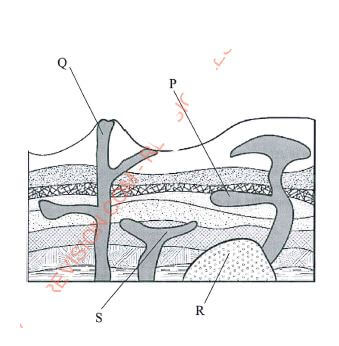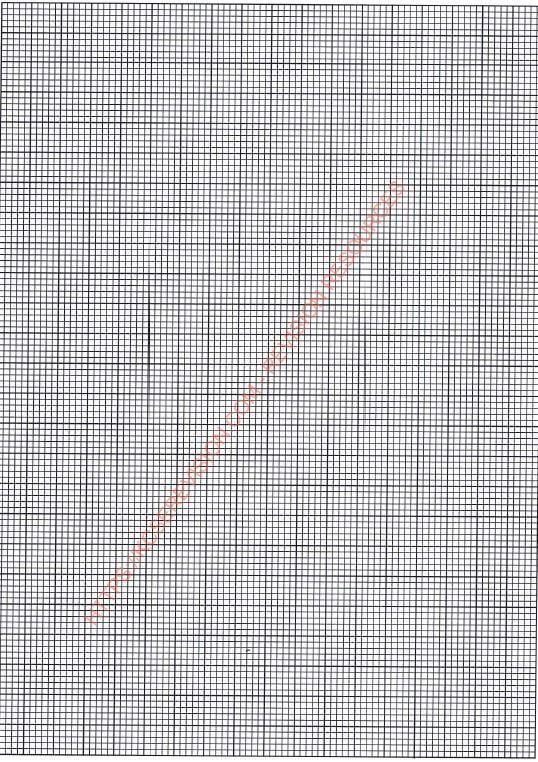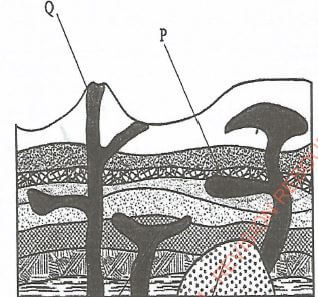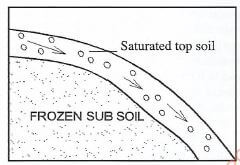QUESTIONS
SECTION A
Answer all the questions in this section.
-
- Define the term atmosphere.(2 marks)
- State the composition of the inner core.(3 marks)
-
- Name three types of folds.(3 marks)
- State three factors that determine the folding of crustal rocks.(3 marks)
- The diagram below represents some volcanic features. Use it to answer the questions below.

Name the features marked P, Q, R and S.(4 marks) -
- Identify the main characteristics of the ocean water.(2 marks)
- Give three factors that influence wave deposition.(3 marks)
-
- List the three types of dunes.(3 marks)
- Identify two processes through which wind transports materials in arid areas. (2 marks)
SECTION B
Answer question 6 and any other two questions from this section
- Study the map of Taita Hills 1:50,000 (sheet 189/4) provided and answer the following questions.
-
- Give the four figure grid reference of the trigonometrical station (2208m).(1 mark)
- What is the general direction of the flow of River Voi (Goshi)? (1 mark)
-
- Measure the length of the road labelled A23. Give your answer in kilometres.(2 marks)
- Citing evidence from the map, identify three social services offered in the area covered by the map.(6 marks)
- Describe the relier of the area covered by the map.(7 marks)
- Citing evidence from the map, explain four factors that may have influenced agricultural activities in the area.(8 marks)
-
-
-
- What is a rock?(2 marks)
- Give two examples of plutonic igneous rocks.(2 marks)
- Describe the processes of formation of each of the following types of sedimentary rocks:
- Mechanically formed.(4 marks)
- Organically formed.(4 marks)
- State the characteristics of rocks.(5 marks)
- You are planning to carry out a field study on rocks within the local environment.
- List three methods you would use to record data.(3 marks)
- State three problems you are likely to encounter.(3 marks)
- Give two economic uses of rocks you are likely to identify. (2 marks)
-
-
-
- Identify the two types of earthquake waves.(2 marks)
- Describe the two ways through which the strength of an earthquake is measured.(6 marks)
-
- Explain how vulcanicity causes earthquakes. (6 marks)
- Name three major earthquake zones of the world.(3 marks)
- Explain four effects of earthquakes on the human environment.(8 marks)
-
-
- Name two types of landslides. (2 marks)
- Explain how each of the following factors influence mass wasting:
- Climate (6 marks)
- Slope (2 marks)
-
- State four causes of soil creep. (4 marks)
- Using a diagram, describe the process of solifluction.(5 marks)
- You intend to carry out a field study on the effects of mass wasting within the local environment.
- Give two methods of data collection that you would use for the study. (2 marks)
- State two negative effects of mass wasting on the physical environment that you are likely to identify.(2 marks)
- Give two follow-up activities you would be involved in after the field study.(2 marks)
-
-
- Name the three types of river erosion. (3 marks)
- Describe each of the following processes of river erosion:
- Abrasion(4 marks)
- Solution (3 marks)
- Describe the characteristics of the upper stage of a river.(6 marks)
-
- What is river rejuvenation? (2 marks)
- Give four causes of river rejuvenation. (4 marks)
- Identify three features that result from river rejuvenation (3 marks)
-

MARKING SCHEME
-
- Define the term atmosphere.
- This is the layer of gases and vapour which surrounds the earth.
- State the composition of the inner core
- It is composed of iron and nickel.
- It has very high temperature/ about 5000°C to 6000°C
- The average density is 13-17gm/cc./very high density
- It is solid in nature.
- Define the term atmosphere.
-
- Name three types of folds
- Simple / symmetrical fold.
- Asymmetrical fold.
- Over fold.
- Recumbent fold.
- Nappe fold./overthrust
- Isoclinal fold.
- Anticlinorium/synclinorium complex
- Monoclinal fold
- State three factors that determine the folding of crustal rocks
- Crustal rocks should be in layers/sedimentary.
- The rocks should be young in order to bend.
- The forces operating on the crustal rocks should be compressional.
- The amount of pressure applied should be high.
- Name three types of folds
- The diagram below represents some volcanic features. Use it to answer the questions below.

Name the features marked P, Q, R and S.- P -Sill (1 mark)
- Q-Vent (1 mark)
- R- Batholith (1 mark)
- S-Lopolith (1 mark)
-
- Identify the main characteristics of the ocean water
- Ocean water is saline salty.
- The temperature of ocean water varies horizontally and vertically.
- Varies in density
- It is in constant movement
- Give three factors that influence wave deposition
- The depth of the water should be shallow along the coast
- Configuration of the coastline change in the alignment of coastline.
- The shore should have a gentle gradient.
- The breaking waves should have strong swash and a weak backwash./constructive waves.
- Ample materials to be deposits
- Identify the main characteristics of the ocean water
-
- List the three types of dunes
- Barchans
- Seif dunes/longitudinal/linear
- Transverse/wave dunes.
- Star dunes
- Draas
- Identify two processes through which wind transports materials in arid areas.
- Suspension
- Saltation
- Surface creep/traction.
- List the three types of dunes
- Study the map of Taita Hills 1: 50,000 (Sheet 189/4) provided and answer the following questions:
Give the four figure grid reference of trigonometrical station-
- (2208m)
- 2122
- What is the general direction of the flow of River Voi (Goshi)?
- Eastwards/south eastwards
- (2208m)
-
- Measure the length of the road labelled A23. Give your answer in kilometres.
- 14.6km (± 0.1)
- Citing evidence from the map, identify three social services offered in the area covered by the map
- Social service
- Evidence
- Health services
- Dispensary/Health centre.
- Religious services
- Church/Mosques.
- Educational services
- polytechnics/Schools.
- Administration services
- chiefs/DC's. Office.
- Rehabilitation services
- Rehabilitation center/prison.
- Security
- police post.
- Water supply
- pump house
- Measure the length of the road labelled A23. Give your answer in kilometres.
- Describe the relief of the area covered by the map
- The land slopes from West to East.
- The western part is a highland while the eastern is a lowland.
- There are many hills in the area covered by the map. Example Mgange Hills/Mragua Hills.
- The area has several river valleys.
- The Eastern part of the area is generally gently sloping.
- The highest point is 2208 metres.
- The lowest point is 620 metres.
- There is rugged landscape in the Western part/there are many ridges.
- There are bluffs/cliffs.
- The North Western part of the Map has steep slopes.
- There are outcrop rocks.
- There are many Cols.
- Citing evidence from the map, explain four factors that may have influenced agricultural activities in the area.
- Presence of road network to provide transport facilities.
- The South Eastern part receives low rainfall as evidenced by scrub vegetation suitable for sisal growth.
- There is availability of labour due to dense settlement at on the Western part around Mgange, Mragua and ,Mwangea
- The Eastern part is sparsely settled widely spaced contours hence mechanization.
- The Western part receives high rainfall as evidenced by forests and permanent rivers which has influenced farming.
- Availability of vertinary services evidenced by cattle dips favour livestock farming.
- Availability of advisory services evidenced by farmers training center favour farming in the area.
-
-
-
- What is a rock?
- A rock is a naturally occurring aggregate of mineral particles forming part of the earth's crust
- Give two examples of plutonic igneous rocks.
- Granite
- Diorite
- Peridotite
- Gabbro
- Syenite.
- Nepheline
- Diabase.
- What is a rock?
- Describe the processes of formation of the following types of sedimentary rocks.
- Mechanically formed
- Sediments used to form the rocks are derived from weathering of existing rocks.
- The weathered materials are transported by wind/ice/water.
- The weathered materials are deposited in layers on land or sea.
- They are then compacted, and cemented into sedimentary rocks.
- Organically formed
- These rocks are formed from remains of dead plants and animals./fossils
- These remains accumulate in the oceans/basins/land, in layers.
- The materials are deposited in layers/strata.
- The accumulated materials are compressed, compacted and cemented into sedimentary rocks.
- Mechanically formed
- State the characteristics of rocks.
- Some rocks have joints.
- Rocks have varied degree of hardness.
- Rocks have cleavage.
- Rocks have varied texture.
- Rocks have different colours
- Some rocks have lustre
- Rocks have varied specific density,
- Rocks have streak.
- Rocks have different minerals,
- Rocks have varied mineral structures.
- You are planning to carry out a field study on rocks within the local environment.
- List three methods you would use to record data.
- Photographing/video recording
- Labelling samples.
- Note taking/recording observations.
- Filling in questionnaires
- Drawing diagrams/sketches.
- Tape recording.
- State three problems you are likely to encounter.
- Accidents may occur.
- Inaccessibility of some areas with rocks.
- Fatigue due to difficult terrain.
- Unfavourable weather conditions that is heavy rains, high temperatures.
- Attack by wild animals/snake bites.
- Difficulty identifying some rocks.
- Difficulty breaking some rocks
- Give two economic uses of rocks you are likely to identify.
- Some rocks are used for construction.
- Some rocks are a Source of fossil fuel.
- Some are used for making carvings.
- Some are sources of valuable minerals.
- Some are tourist's attractions.
- Some rocks store underground water/for irrigation.
- Rocks weather to form soils for agriculture.
- Some rocks for example limestone is a raw material/ cement manufacture.
- List three methods you would use to record data.
-
-
-
- Identify the two types of earthquake waves.
- Body waves/primary/secondary
- Surface waves/love/Rayleigh
- Describe the two ways through which the strength of an earthquake is measured.
- The strength of an earthquake is measured by its intensity.
- Intensity measures how strong and hard the earthquake shakes the ground.
- It is measured on Mercalli scale.
- The strength of an earthquake is measured by its magnitude.
- Magnitude measures the amount of energy released by an earthquake.
- It is measured on Richter scale correct method
- Identify the two types of earthquake waves.
-
- Explain how vulcanicity causes earthquakes.
- Sudden displacement of crustal rocks during vulcanicity causes tremors.
- Violent volcanic eruptions/violent emissions of the volcanic gases can shake/shatter the rocks/tremors.
- After volcanic eruption, a large void is created below the crust which causes the crustal rocks to sink due to gravity this causes the earth's surface to shake.
- Magma movement within the crust can cause tremors.
- A sudden eruption of molten magma under the oceans can cause earth tremors as the water on the sea floor violently expands.
- Name three major earthquake zones of the world
- The Great Rift Valley belt.
- The Mediterranean
- Himalayan belt.
- The circum-Pacific belt. /ring of fire.
- Mid-Atlantic Ocean belt.
- Explain how vulcanicity causes earthquakes.
- Explain four effects of earthquakes on human environment
- Earthquakes lead to shaking/crumbling of buildings leading to their destruction.
- Earthquakes may lead to the falling of objects which may lead to loss of life.
- Earthquakes may damage transport networks making movement difficult.
- It may lead to destruction of electric lines/pipelines resulting to blackouts/fire incidences.
- A large-scale sea wave caused by an undersea earthquake/Tsunami may flood the coastal lowlands leading to destruction of agricultural land.
- Disturbances caused by earthquakes lead to landslides which crush and bury people/property.
- Earthquakes may lead to collapsing of underground mines which may lead to burying of miners.
- Earthquakes cause panic/anxiety/emotional shock.
- Destruction of property leads to evacuation/displacement of people.
- Strong earthquakes cause damage to nuclear plants/sewerage systems which pollute the human environment.
-
-
- Name two types of landslides.
- Slump
- Debris slide
- Rock slide
- Debris fall
- Avalanche
- Rock fall.
- Explain how the following factors influence mass wasting
- Climate
- Areas that receive high rainfall experience massive landslides on steep slopes/ areas that receive low rainfall have slow movement of rock materials down the slope.
- In areas with large diurnal range of temperature there is expansion and contraction of soil particles which leads to movement of the soil particles.
- Alternate freezing and thawing encourage mass movement of rock and soil materials.
- Slope
- Steep slopes encourage faster movement of material down the slope. Gentle slopes have slow movement of materials down the slope.
- Climate
-
- State four causes of soil creep
- Ploughing on a slope loosening the soil particles.
- Wetting and drying of soil particles.
- External forces such as earthquakes/ explosives/eruptions/heavy vehicles movements.
- Frost heaving beneath the soil.
- Alternate heating and cooling of the soil particles.
- Undercutting of the base of the slope through road construction/mining,
- Using a diagram, describe the process of solifluction.

- In moderately/gentle sloping areas during winter water in the soil freezes thus freezing the soil.
- When the weather becomes warm the top soil thaws.
- Overtime the top soil becomes saturated with water while the sub soil remains frozen (permafrost).
- The saturated mass of top soil creeps over the frozen ground (permafrost).
- State four causes of soil creep
- You intend to carry out a field study on the effects of mass wasting within the local environment
- Give two methods of data collection that you would use for the study.
- Observing.
- Administering questionnaires.
- Photographing/video recording.
- Reading from secondary sources/viewing films/video clips.
- State two negative effects of mass wasting on the physical environment that you are likely to identify.
- Destruction of vegetation.
- Dereliction of land /scars
- Blockage of rivers.
- Exposure of land to soil erosion.
- Give two follow-up activities you would be involved in after the field study.
- Data analysis/discussion about findings.
- Report writing.
- Data presentation.
- Consulting geography teachers.
- Display photographs taken.
- Drawing conclusions.
- Reading more on the topic.
- Give two methods of data collection that you would use for the study.
- Name two types of landslides.
-
-
- Name the three types of river erosion
- Head ward erosion/spring sapping.
- Vertical erosion.
- Lateral erosion.
- Describe the following processes of river erosion.
- Abrasion
- The river transports the materials downstream.
- The materials are used by the river as tools for scouring,
- The load is hurled by the water against the banks and dragged along the river bed.
- The load chips off the rocks on the bank and river bed.
- The load being dragged smoothens the river bed.
- The eddy currents rotate the load in the hollows on the river bed grinding the rocks widening into potholes.
- Solution
- River water contains both organic and weak inorganic acids.
- It reacts with some minerals in some rocks in the river bed to form soluble minerals.
- The soluble minerals are carried downstream in solution form
OR - River water flows over rocks with soluble minerals.
- The water dissolves soluble minerals to a solution.
- The minerals are carried away in solution.
- Abrasion
- Name the three types of river erosion
- Describe the characteristics of the upper stage of a river.
- The gradient is steep.
- The river has a small load.
- The flow of the river is fast.
- Vertical erosion is dominant.
- The cross profile of the valley is v-shaped.
- It has interlocking spurs.
- The river valley is deep.
- The river channel is narrow.
- Some parts of the river course have rapids/waterfalls/cataracts.
- The river volume is low.
- The river channel is winding.
-
- What is river rejuvenation
- This is the renewal of a rivers erosive ability/activity/power.
- Give four causes of river rejuvenation.
- Increase in river discharge.
- Change in rock resistance.
- Unequal regional subsidence.
- Regional/local uplift of the land.
- Fall in sea level/drop in sea level.
- Identify three features that result from river rejuvenation.
- Knick points.
- Rejuvenation terraces/paired terraces.
- Incised meanders/in grown/entrenched meanders.
- Rejuvenation gorges/valley within a valley.
- What is river rejuvenation
-
Join our whatsapp group for latest updates
Tap Here to Download for 50/-
Get on WhatsApp for 50/-
Download KCSE 2018 Geography Paper 1 with Marking Scheme.
Tap Here to Download for 50/-
Get on WhatsApp for 50/-
Why download?
- ✔ To read offline at any time.
- ✔ To Print at your convenience
- ✔ Share Easily with Friends / Students

